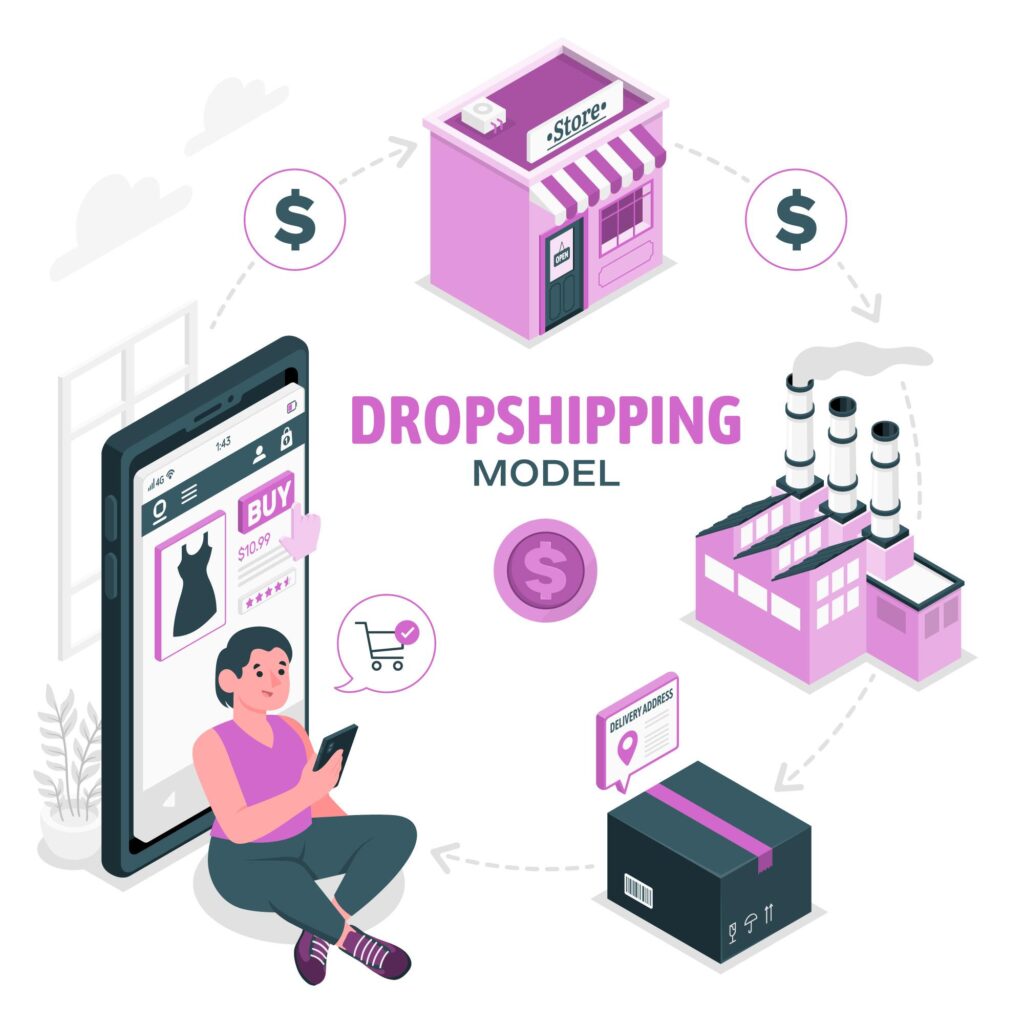Introduction:
Starting an online business by knowing How to Create a Drop Shipping Website can be very exciting, especially when you don’t need to worry about storing products, packing, or shipping them. This is possible through my preferred business model called drop shipping. With drop shipping, you sell products on your website, but you don’t have to keep them in stock. Instead, when a customer places an order, you purchase the product from a supplier who ships it directly to the customer. It’s a low-risk way to start an eCommerce business. In this article, I’ll walk you through how to create a drop shipping website step by step with my real experience.
Table of Contents

Step 1: Choose Your Niche
Before you start building your website, you need to decide what products you want to sell. This is called choosing your niche. Your niche should be something you’re interested in and something that has a market demand. For example, you could choose a niche like eco-friendly products, pet accessories, or tech gadgets.
To pick the right niche, consider these factors:
- Passion and Interest: You should be interested in the products you’re selling. This will keep you motivated.
- Market Demand: Research what products are popular. Use tools like Google Trends or keyword research tools to find out what people are searching for.
- Competition: Check out other online stores in your niche. If the market is too crowded, it might be hard to stand out. But if there’s little competition, it could mean there’s not much demand.
Step 2: Find Reliable Suppliers
Once you’ve chosen your niche, the next step is to find suppliers who will provide the products. The suppliers you choose are critical to your success because they handle the product quality and shipping.
Here are some ways to find reliable suppliers:
- Drop Shipping Platforms: Websites like AliExpress, Oberlo, and SaleHoo connect you with suppliers that offer drop shipping.
- Contact Manufacturers: Reach out directly to manufacturers of the products you’re interested in. Ask if they offer drop shipping services.
- Online Marketplaces: You can also find suppliers on marketplaces like eBay or Amazon, but be cautious about the reliability and quality of these suppliers.
Make sure to check the suppliers’ reviews and ratings before partnering with them. Good communication and reliability are essential.
Step 3: Choose a Website Platform
Now that you have your niche and suppliers, it’s time to build your website. To do this, you’ll need to choose a platform that allows you to create an online store. Here are some popular platforms:
- Shopify: Shopify is one of the most popular eCommerce platforms. It’s easy to use and has many dropshipping apps that integrate seamlessly. You can customize your store with themes and add products easily.
- WooCommerce: If you prefer using WordPress, WooCommerce is a great option. It’s a plugin that turns your WordPress site into an online store. WooCommerce is highly customizable and works well for drop shipping.
- BigCommerce: BigCommerce is another powerful eCommerce platform. It’s user-friendly and has many built-in features that are useful for drop shipping.
- Wix: Wix is known for its drag-and-drop website builder. It’s easy to use and has eCommerce features that are suitable for drop shipping.
Choose a platform based on your budget, technical skills, and the features you need. Shopify and WooCommerce are the most commonly used platforms for drop shipping.
Step 4: Set Up Your Online Store
After choosing your platform, the next step is to set up your online store. This includes selecting a domain name, designing your website, and adding products.
- Domain Name: Your domain name is the web address of your store (e.g., www.yourstore.com). Choose a name that reflects your niche and is easy to remember. You can buy a domain name from websites like GoDaddy, and Namecheap, or directly through your website platform.
- Design Your Website: The design of your website is important because it affects how customers perceive your brand. Most platforms offer templates or themes that you can customize. Choose a theme that matches your niche and is mobile-friendly.
- Add Products: Now it’s time to add the products you want to sell. When adding products, make sure to include high-quality images, clear descriptions, and accurate pricing. You can import products directly from your supplier using apps like Oberlo (for Shopify) or AliDropship (for WooCommerce).
Step 5: Set Up Payment Methods
To accept payments from customers, you need to set up payment methods on your website. Most eCommerce platforms support a variety of payment gateways, such as:
- PayPal: A popular and trusted payment method worldwide.
- Credit/Debit Cards: You can set up credit and debit card payments using payment processors like Stripe, Square, or Shopify Payments.
- Apple Pay and Google Pay: These are becoming more popular, especially for mobile shoppers.
Ensure that your payment gateway is secure, as this will build trust with your customers.
Step 6: Create a Shipping Policy
Even though your supplier handles the shipping, it’s important to have a clear shipping policy on your website. This policy should include:
- Shipping Costs: Clearly state whether you offer free shipping or if there are any charges.
- Delivery Times: Provide an estimate of how long it will take for customers to receive their orders. Be sure to communicate any delays upfront.
- Returns and Refunds: Outline the process for returns and refunds. This will help manage customer expectations and build trust.
Step 7: Optimize for SEO
Search Engine Optimization (SEO) is crucial for driving traffic to your drop shipping website. SEO helps your website appear higher in search engine results, making it easier for customers to find you.
Here are some basic SEO tips:
- Use Keywords: Research and use relevant keywords in your product titles, descriptions, and blog posts. Tools like Google Keyword Planner can help you find the right keywords.
- Write Unique Descriptions: Avoid copying product descriptions from your supplier. Write unique descriptions that include your target keywords.
- Optimize Images: Use alt text for your images and compress them to improve page load speed.
- Create a Blog: Blogging is a great way to improve SEO. Write articles related to your niche to attract more visitors to your site.
Step 8: Market Your Website
Once your website is live, you need to attract customers. Marketing is key to the success of your drop shipping business. Here are some effective marketing strategies:
- Social Media Marketing: Use platforms like Facebook, Instagram, and Pinterest to promote your products. You can also run paid ads to reach a larger audience.
- Email Marketing: Build an email list and send regular newsletters with promotions, new products, and updates. Email marketing is a great way to engage with your customers and encourage repeat purchases.
- Influencer Marketing: Partner with influencers in your niche to promote your products. This can help you reach a targeted audience quickly.
- Google Ads: Run pay-per-click (PPC) ads on Google to drive traffic to your website. This can be particularly effective if you’re targeting specific keywords.
Step 9: Manage Your Business
As orders start coming in, it’s important to manage your business efficiently. Here’s how:
- Order Management: Keep track of orders and communicate with your suppliers to ensure timely shipping. Most eCommerce platforms offer tools to help you manage orders and inventory.
- Customer Service: Provide excellent customer service by responding to inquiries promptly and resolving any issues. This will help build a positive reputation for your brand.
- Monitor Analytics: Use tools like Google Analytics to monitor your website’s performance. Track metrics like traffic, conversion rates, and sales to understand what’s working and where you can improve.
Conclusion:
Creating a drop shipping website is a great way to start an online business with minimal risk and investment. By following these steps, you can build a successful drop shipping store that attracts customers and generates sales. Remember, the key to success is choosing the right niche, finding reliable suppliers, and effectively marketing your products. With dedication and the right strategies, your drop shipping business can thrive.
So, what are you waiting for? Start building your drop shipping website today and take the first step towards becoming a successful online entrepreneur!
Read this to learn about Print On Demand without any investment.
